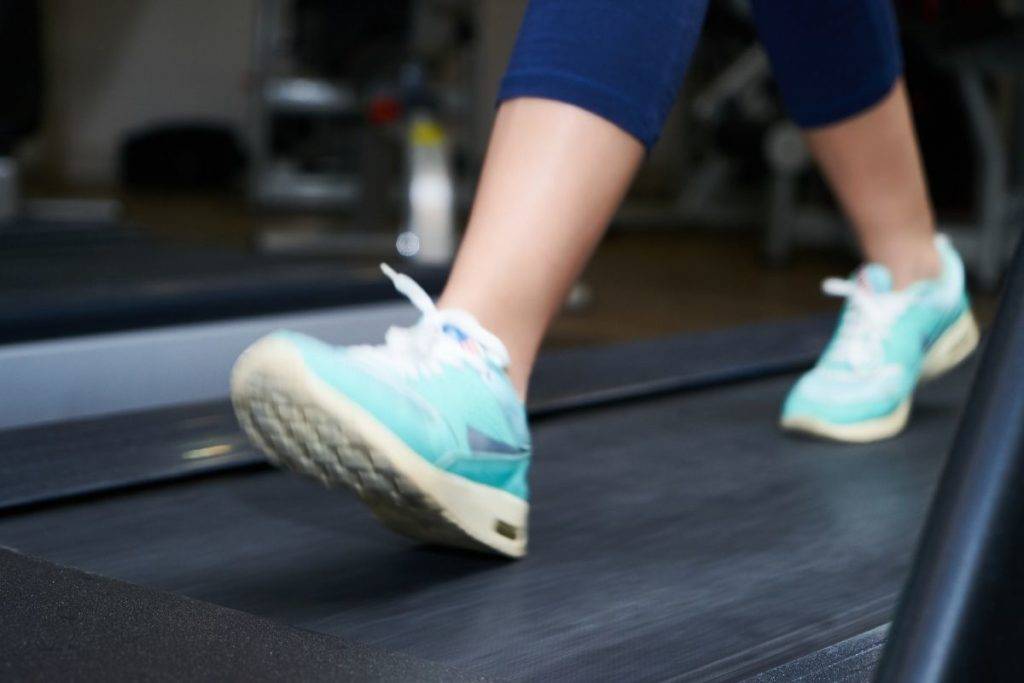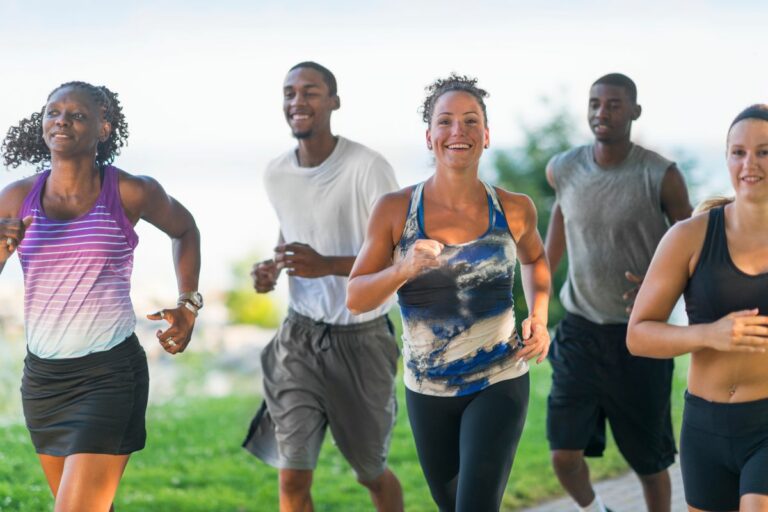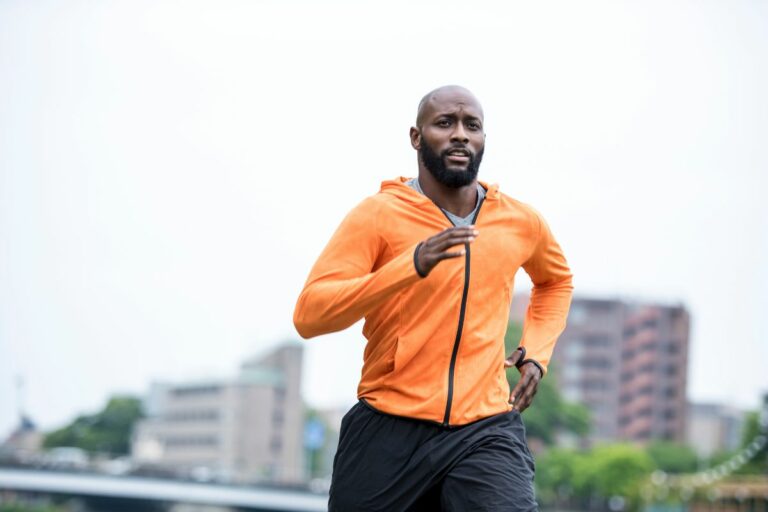What Does Pace Mean In Running? Tips For Beginners

If you are just beginning your running journey you are probably hearing a number of terms, such as form, cadence, foot strike, stride, and pace.
- Pace is minutes per km or mile.
- For example, if it took 40 minutes to run 5 miles, divide 40 by 5. You get the pace of 8 minutes per mile.
In this guide, we look at what they mean but focus on running pace and how you can safely achieve your desired pace without causing any injuries.
Guide To Terms Used In Running
When talking about running, you’ll often hear these 5 terms:
1. Pace
Pace refers to the time it takes to cover a certain distance.
Pace measures how fast you are running per kilometer or mile. Lower values mean you are moving faster, and higher values mean you moving slower.
Fitness trackers typically show the pace of your runs on their dashboards. Some devices show the current pace on their screen when you are running.
Note: When using Fitbit or similar to track your runs, adjust the units of measurement to what you are using (miles or kilometers).
Example: 5K run took 36 minutes.
- Pace in kilometers: 36 minutes / 5 kilometers = 7.2 = 7:12 minutes / kilometer.
- Pace in miles: 36 minutes / 3.1 miles = 11.6 = 11:36 minutes / miles.
You can see how many miles popular distances like 5K and 10K are from here.
You can calculate your finish time for popular race distances based on your expected pace with Strava running pace calculator.
2. Cadence
Cadence refers to the number of steps a runner takes per minute while running.
Your cadence will depend on the pace you are traveling at as well as the distance and the length of your legs.
In our other article, we discuss what is a good running cadence.
3. Stride
Finding your stride while running is a longed-for feeling.
This is when you find a comfortable speed you can run at.
You can easily maintain that speed without over-exerting yourself.
Your stride refers to the number of steps that you take forward as you run.
4. Foot Strike
This is a very important part of running. Foot strike refers to how your foot hits the ground.
If you are hitting the ground incorrectly you can easily fall or lose your balance as well as negatively impact the muscles in your foot, ankles, knees, and lower back.
Remember what we spoke about earlier regarding your form, your foot should roll like a wave, heel to toe, heel to toe.
5. Form
How you hold your body when running is extremely important. You need to support your body as it exerts itself during this form of exercise.
The correct running form is to bend your elbows at a 90-degree angle and allow them to SWING as you move forward.
Slightly lean your chest forward to help propel your body and then it’s a case of placing one foot in front of the other.
As your foot hits the ground it should roll like a wave going from your heel to your toe.

What Is A Good Pace For Running?
There is NOT one set pace that would apply to every runner.
For more info on this, we also have an article covering how to pace yourself when running (simple tips to avoid fatigue).
Your pace is influenced by a number of factors such as your age, how long you have been running, and also your running ability.
Let’s take a look at how long it takes to run a mile on average:
- For beginners, it can take 10-15 minutes to complete a mile.
- A person in good shape and health who runs each week for leisure could run a mile in approximately 9 to 10 minutes.
- Elite marathon runners can run a mile in as little as 4 minutes.
How to Find Your Pace?
The best way to find your average pace is to complete 3 runs of a certain length and time them.
Once you have completed these runs add the times together and divide it by three to find on average what your pace is.
How to Calculate Your Average Pace?
Pace = time per distance (in miles or in kilometers).
For example, the average pace based on 3 runs:
- You run one mile three times on separate days. It took 15, 17, and 14 minutes.
- Calculation: 15 + 17 + 14 = 46 / 3 = 15.333
- Your average pace is 15:20 min/mile.
Pace for 3 miles?
For the average runner, it takes 30 to 45 minutes to run 3 miles.
Examples of 3 mile run times:
- 45 minutes to run 3 miles, 45 / 3 = 15, pace is 15:00 min/mile.
- 40 minutes to run 3 miles, 40 / 3 = 13.33, pace is 13:20 min/mile.
- 35 minutes to run 3 miles, 35 / 3 = 11.66, pace is 11:40 min/mile.
- 30 minutes to run 3 miles, 30 / 3 = 10, pace is 10:00 min/mile.
A 3-mile run is a good run to aim for as an beginner/average runner. Aim to run 3 miles without stopping to see if you achieve this pace. If not you would know that you need to work on your endurance.
When you can run the 15 min/mile pace without any discomfort you should try to achieve a slightly better pace to aim for 3 miles in 40 minutes, and so on.
An average runner will run one mile in 10 minutes or under, but you can’t keep up that same one-mile pace on longer runs.
How To Increase Your Pace
Often we will have a set pace that we HOPE to achieve.
You could go out and run as FAST as you can trying to achieve this pace.
But we would NOT recommend this!
You could cause serious damage to your muscles as well as possibly not gain any results.
We RECOMMEND that you follow the below tips that will help you to increase your running pace:
- Run often. This will help your endurance. It will prevent you from fatiguing during your run leading you to stop. Your aerobic health will get better also meaning you won’t get out of breath.
- Focus on your form. Having good form will enable you to run faster
- Play with speed. Include recovery runs, tempo runs, sprinting, fartleks, and hill work to directly benefit your endurance, form, and pace.
- Get a training partner. Having someone to motivate you can be helpful. Ensure you choose someone who is at the same running level so it benefits you positively.
The Bottom Line
Most people run at various paces depending on the distance or what kind of training they are having. And for most, the pace slows down when they age.
If you slow down more, you can say you are jogging (although there is no strict pace or speed with running vs. jogging, some say it’s 10 min/mile).
If you plan on running even faster (for example, run 5K in 20 minutes with a 6:26 pace), remember to play with speed and vary your training with sprint training and fartlek runs.





